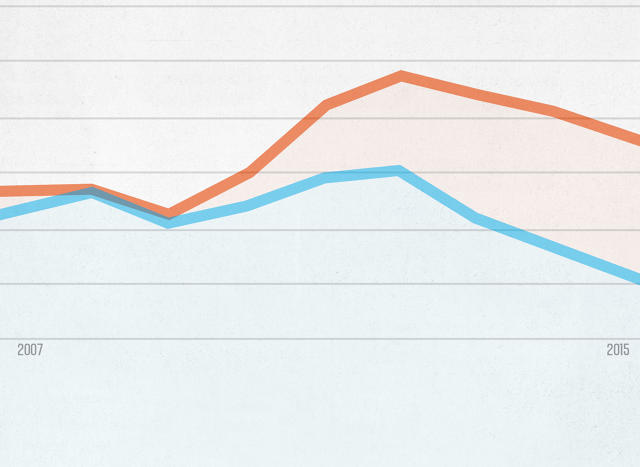What Killed The Infographic?
if you’ve viewed fewer experimental knowledge visualizations lately, it can be best since the medium has grown up and gotten a job.
could 6, 2015
a couple of years in the past, the internet was once awash in groundbreaking data visualizations. There used to be Aaron Koblin’s deeply influential map of flight patterns across the U.S. Periscopic’s exhaustive, haunting portrait of gun violence in the U.S.. Jer Thorp and John Underkoffler’s Minority report-like interface for exploring the galaxy.
these days, you would be lucky to discover a low cost knockoff in a world dominated by using crappy promotional infographics churned out for viral attention3023974″ data-name=”peoplePages”> Nicholas Felton, the info viz guru who once designed fb’s Timeline, now builds apps. Jer Thorp is as concerned with reverse-engineering algorithms and information art as he’s in producing pure knowledge visualization. Even the infographics on the portfolio-sharing site Behance are on the downswing. “Infographic posting normally rose often from 2007 to 2012, the place it peaked, and has begun to decline on the grounds that then,” Sarah Rapp, Head of Behance group information & Insights, Adobe, writes in an electronic mail.
Nicholas Felton, the info viz guru who once designed fb’s Timeline, now builds apps. Jer Thorp is as concerned with reverse-engineering algorithms and information art as he’s in producing pure knowledge visualization. Even the infographics on the portfolio-sharing site Behance are on the downswing. “Infographic posting normally rose often from 2007 to 2012, the place it peaked, and has begun to decline on the grounds that then,” Sarah Rapp, Head of Behance group information & Insights, Adobe, writes in an electronic mail.

Infographics, it appears, are a dying breed. aside from that in talking to a dozen data visualization specialists internationally’s high studios, I discovered that the story is far more nuanced. once a playground for impartial designers, information visualization has developed into something more mature, company, and trustworthy about its failings. The quirky, experimental infographics that when peppered the web is also disappearing. but that’s only as a result of information visualization, as a medium, has eventually grown up and gotten a job.
information Viz Has long gone corporate
Years ago, the hardest part of a knowledge visualization fashion designer’s job used to be explaining what he did and why it used to be rewarding. nowadays, businesses starting from the presidential campaigns of Hillary Clinton and Barack Obama to the arena financial institution searching for out knowledge visualization consultants. business is excellent. Most design studios I talked to had just lately became down work. a few years ago, they mentioned, firms engaged in complex financial negotiations to get a visualization performed; now it’s a standard, budgeted line merchandise. GE counts among the many firms which have made main investments in information visualization.
The upshot is that one of the vital perfect information visualization work goes unseen, as Fortune 500 firms rent data visualization designers for NDA work or snatch them up for full-time work. ahead of we spoke, the Portland-based firm Periscopic had simply met with Nike to help the corporate gather an inner information visualization crew, while Jer Thorp—whose work has been featured in all places from the the big apple times to the big apple’s Museum of brand new artwork—lamented to me that one in all his interns had just lately left for Apple. “We’re never going to look anything he makes, and he’s one of my most gifted students over the past decade,” Thorp says. “It’s fascinating to suppose, maybe he’s making crazy, innovative issues, however we don’t see them.”
just what number of designers and companies are engaged on covert visualization projects is inconceivable to quantify. but most data viz specialists I spoke to had either engaged, or understand of any person who had engaged, in company work under non-disclosure agreements. that includes Stamen, a San Francisco-based totally design agency whose gorgeous, painterly maps counted among the many internet’s early viral visualizations. “To me, it’s about upping our sport,” explains CEO Eric Rodenbeck, “[and] less about making the next new factor that will get on BuzzFeed.” so far, Stamen has made pictures for everybody from Twitter, to MSNBC, to BMW, to MTV.
device Has changed Hand-Coded Quirk
only some years in the past, data visualization designers needed to custom-code and design their tasks—an exhaustive process which required constructing every visible like its personal app. as of late, a slew of latest software has made it more uncomplicated than ever to create data visualizations from scratch. The downside? It has resulted in extra prescriptive design. Take D3. it is a JavaScript library that helps turn information into any choice of visible frameworks. Most specialists I spoke to agree that D3 is a great tool with a robust neighborhood of supporters including both hardcore statisticians and designers. Publications just like the the big apple occasions use D3 of their work day by day. however shareable, precanned templates developed for D3 have eaten into a lot of the quirk that’s missing in lots of new information visualizations.

beyond D3, there are several visualization tools available to the untrained masses. Tableau is the crown jewel. based in 2003, it’s a piece of visualization tool costing corporations $1,000 per consumer, and it can be taken off in the past year as more firms take their visualizations in-house. Tableau collected $412 million (or about 1/2 its lifetime earnings) in 2014, and the instrument is now utilized by greater than 26,000 companies around the globe.
Tableau is just a little like Excel. It has a drag-and-drop user interface that lets users import spreadsheets and instantly flip them into all different types of simple charts. The charts have been algorithmically shaped and colour-coded to adapt to Edward Tufte-approved academic research—in different phrases, with out a training in any respect, everyday employees can understand their work is more or less consistent with that of the most influential knowledge dressmaker of the 20th century. As CEO Christian Chabot boasts, the sort of visualization which you could build in minutes with Tableau’s free demo device would have cost you $a hundred,000 10 years in the past, paid to an organization like Stamen.
Now, it will now not be the arena’s most ingenious knowledge visualization. but that’s one of the crucial tradeoffs. “there’s a new geek on the town. the new geek is the data geek. consider it or not, they’re all over the place,” Chabot says. “5 years from as of late, i feel it is going to be very common for folk in all professions to use information in all elements of their jobs … [and] it’s going to be not unusual that you have tools, as popular as word, that let you interrogate data and discover your curiosities.”
mobile Is changing The personal computer
5 years in the past, data visualizations had been designed mostly to be seen on computer computer systems. these days, smartphones and tablets characterize roughly 50% of the web’s site visitors. That’s an enormous chunk of internet mindshare that a sprawling, formidable data visualization could be wasted on. So now, simple bar graphs, comparable to those you see on the trade news web page Quartz, frequently make more feel to publish than deep interactive content.

“Our work is predicted to work on cell now, which just constrains the varieties of concepts one has (and has vitality to do),” Amanda Cox, images editor on the big apple occasions‘ The Upshot writes in an email. “every so often the simpler (will work all over the place) version is healthier, occasionally it is not.”
Publications—like the occasions, Bloomberg, and FiveThirtyEight—are among the biggest avid gamers in mainstream data visualization lately, however they have to stability limited resources every day. Media companies which can be strapped for cash run skeleton crews that are below constant power to pressure visitors to their stories, because eyeballs correlate to promoting earnings. because of this, you may have one of the vital world’s most gifted visible designers churning out more effective content material that everyone can access on a cellphone, slightly than rich, complicated interactives to be able to have an inherently smaller readership.
perception Is changing Infographics
a grimy little secret about knowledge visualization is that it doesn’t all the time present as much insight into huge datasets as you might hope. “To me, i take advantage of the human genome venture as a psychological version here. the idea was once once we mapped the genome, we’d unlock the doors to all of these things, we’d treatment diseases, find new drugs,” the info artist Jer Thorp says. “It used to be going to vary things. but mapping the genome taught us how little we all know. i believe what we wish to consider with giant knowledge is that the identical thing can occur. large information does not best lead to solutions it additionally results in questions.” In different words, the very medium of data-rich infographics might now not be proper for common consumers.

Even Nicholas Felton, who gained cult standing in the information visualization world for mapping every minute element of his existence, questions the usefulness of many visualizations. “Don’t get me flawed, i really like the viz! however i’m looking to predict where I see product and tradition going,” he says. “i think, possibly information viz is at all times going to be this type of the nerd’s game. I do not know if it’s going to be more than additive in quite a lot of circumstances.” He points to firms like Apple, which is embracing Healthkit, a platform to turn well being metrics into snazzy pics. “HealthKit is an instance where it’s like, i don’t want to see this stuff,” Felton says. “I don’t recognize why you’re exhibiting me bar graphs and allowing me to get admission to a database to show me each step I’ve taken for the final six months. It’s not vital. Do one thing helpful with it.”
So the place is that this All Going?
as an alternative of information visualization, Felton imagines a future constructed upon pure insight. no one desires to peer a weather radar, he contends, when all you in point of fact need to know is whether or not you need an umbrella. That suggestion will also be condensed into a single, textual content-primarily based push notification—any other comfort of a cell-first world.
however that’s only one future. Periscopic’s Kim Rees urged that visualization could transform a coding language. think about if that you must code in photographs and images as a substitute of the esoteric languages you could have as of late. App design and debugging could be made more straightforward. Stamen’s Eric Rodenbeck imagines very specialised visualizations working their means into the hands of the small trade proprietor—like an Uber driver managing her non-public fleet. And nearly every studio I talked to pointed to a coming trend, during which data visualization designers participate in the data curation step, gathering their own data from a world stuffed with sensors that we’ve barely begun to believe, to make their own work extra related.
Indie infographics aren’t useless. They’ve just grown up.
This story has been up to date with a extra specific attribution concerning Behance research, and clarified that D3 visual frameworks aren’t precoded by means of nature.
(192)













